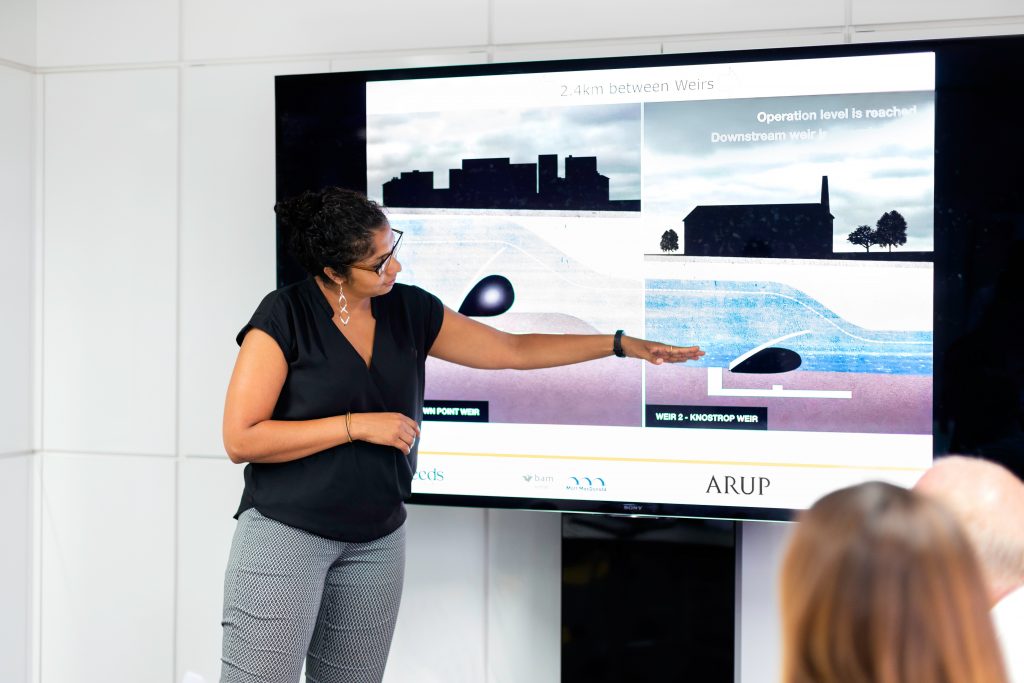
Image by Jordan Nicholson from Disability IN
Primer on accessibility and digital course design
Modified from the MB Hub blog post “Accessibility and Usability in Online Course Design” written by Sasha White, Instructional Designer from December 8, 2021.
Revised by JJ Cloutier
Content reviewed September 2023
- Accessibility vs Accommodation
- Defining accessibility and accommodation in layman’s terms
- Proactive vs. reactive design
- Frameworks that support accessibility and usability in online course design
- Universal Design for Learning
- Quality Matters
- Web Content Accessibility Guidelines
- How do we then define an accessible and usable online course?
- Best practices in accessibility and usability
- Additional strategies
- Conclusion
- Help for your online or blended course
- Additional resources
Accessibility vs Accommodation
Do we then design an online, blended or distributed course to be:
- Accessible?
- To accommodate?
- Or can it be both?
Defining accessibility and accommodation in layman’s terms
Accessibility is what we should expect to be ready for us without asking or planning ahead. It can be provided by following an easy to implement set of standards and practices that make “adaptation” unnecessary. We can benefit from accessibility without announcing or explaining our disabilities.
Accommodation is for adaptations that can’t be anticipated or standardized. They are different for each individual. Although we should expect there to be a general willingness to accommodate us wherever we go, we can’t expect actual, specific accommodations unless and until we ask for them. We do have to announce, and may have to explain our disabilities a bit in order to get accommodations.
Accessibility is the baseline of equal service, and accommodation is the second step to take when accessibility alone isn’t enough.
Andrew D. Pulrang, 2013
In an EDUCAUSE article, Martin LaGrow highlights a couple of differences between accessibility and accommodation:
| Accessibility | Accommodation |
| A proactive solution to providing equal access for all | A reactive solution to address special cases |
| What we should expect to be ready for us without asking or planning ahead. Accessibility can be provided by following an easy-to-implement set of standards and practices that make ‘adaptation’ unnecessary. We can benefit from accessibility without announcing or explaining our disabilities. | For adaptations that cannot be anticipated or standardized, Accommodation varies from one individual to another. Although we should expect a general willingness to accommodate us wherever we go (or, in this case, taking an online course), we cannot expect specific accommodations unless and until we ask for them by explaining our disabilities. |
Designing with accessibility (and usability) means that all course content and interactions are available to learners with diverse needs. The legal basis for accessibility compliance in Manitoba is rooted in the Accessibility for Manitobans Act (AMA). The AMA mandates that public sector organizations, which universities and colleges fall under, must remove barriers, create access to education, and provide a more encouraging and welcoming environment for all students, faculty, and staff.
The AMA has several standards being phased-in over several years covering different sectors and sizes of organizations. The standards areas include:
- Accessible customer service (enacted)
- Accessible employment (enacted)
- Accessible information and communication (Compiance date May 1, 2024, for public sector organizations)
- Accessible transportation (In development)
- Accessible design of outdoor public spaces (In development)
Proactive vs. reactive design
An online course environment that is inaccessible and unusable upfront places a huge burden on students with disabilities as they need to work with the student accessibility office to access the course. They are immediately disadvantaged compared to students without accommodation requests, as they can fully engage in the course until their needs are met. This is a traditional reactive mindset, which makes changes after the fact or only when specific circumstances warrant it.
When you design a course and course materials to be accessible and usable, you are proactive and will eliminate many accommodation requests and allow many more students with disabilities to engage more fully with your course from the beginning.
Note: Even when you design courses and materials with the best accessibility practices, there will still be situations where students will require accommodations.
Frameworks that support accessibility and usability in online course design
Universal Design for Learning
Accessibility and usability are often included in the large umbrella of Universal Design for Learning (UDL), a set of principles for curriculum development that intends to provide all individuals equal opportunities to learn.
Accessibility is captured explicitly in the second principle of UDL, which is multiple means of Representation:

The information must be accessible and presented in various ways (audio, print, tactile, graphically, by video) in as many possible ways as possible to ensure that people get the information they need.
Quality Matters
Quality Matters design standards general standard 8 is dedicated to “Accessibility and Usability,” which states course design requires reflecting a commitment to ensuring diverse learners can access course content and activities and can easily navigate and interact with course components by utilizing the principles of accessibility and usability (Quality Matters, 2023). Specific Review Standard (SRS) of the QM framework more precisely emphasizes the accessibility of text (SRS 8.3), images (SRS 8.4), video and audio (SRS 8.5) content in the course along with the information on the accessibility of technologies used in the course (SRS 8.7) and making accessibility policies or services information available for learners (SRS 7.2).
Web Content Accessibility Guidelines
Creating content within learning management system (LMS) pages is also influenced by Web Content Accessibility Guidelines (WCAG) – a set of voluntary international guidelines for making web content accessible. With its most recent version being 2.1, WCAG consists of twelve broad guidelines under four principles of accessibility, namely:
- Perceivable: Information and user interface components must be presentable to users in ways they can perceive.
- Perceivable content will make it possible for all your students to see and hear the information you’re presenting.
- Operable: User interface components and navigation must be operable.
- Operable content will help all your students navigate the information independently using their preferred tools.
- Understandable: Information and the operation of the user interface must be understandable.
- Understandable content will support your students’ understanding through a consistent and predictable design.
- Robust: Content is robust enough to be interpreted reliably by a wide variety of user agents, including assistive technologies.
- Robust content will work for your students on various current and future technologies, including assistive technologies.
How do we then define an accessible and usable online course?

An accessible and usable online course is:
- Intuitive: The layout of your course is simple, consistent, and predictable
- Perceivable: You have designed your content to be perceived by a wide range of users, regardless of disability.
- Navigable: Course navigation does not assume the student uses a specific device (e.g., mouse). Your student should be able to navigate the course using the keyboard alone or assistive technology equally effectively.
Best practices in accessibility and usability
Many accessibility and usability issues in instructor-created course content can be prevented by following three relatively easy practices that will significantly improve accessibility and usability for your online course:
- Use headings and built-in style features
- Headings (Word)
- Add a heading (Word) – Windows, Mac
- Create a bulleted or numbered list – Word, PowerPoint
- Built-in layouts (PowerPoint) – What is a slide layout, Apply a slide layout
- Write concise and meaningful link text
- Provide alternative text (alt-text) where appropriate
Additional strategies
Additionally, you can improve accessibility and usability by incorporating the following strategies in your online course:
- Provide clear, explicit instructions to students on what to do in the course
- Organize your content in consistent ways
- Write content pages, assignment instructions, etc. in an active, 2nd person voice. They should also be clear to people with a student-level understanding of the course.
- Proofread your content to minimize distractions
- Use easy-to-read fonts
- If using colour, contrast should be strong enough for people to see. Furthermore, do not use colour alone to convey information.
- If using images, ensure that they are crisp and clear, as well as relevant to break up longer sections of text.
- If creating videos, they should be delivered in an accessible media player with captions and/or a transcript. An audio description should be provided to describe important visual content (e.g., on-screen text or key actions not obvious from the audio) to visually impaired students.
Conclusion
When you utilize the best practices we have shared here to enhance accessibility and usability in building your online course and materials, you will not be scrambling when a student requires accommodation because you have already done most of the work. Designing your online course thoughtfully and inclusively helps create an environment where all students, regardless of disability, have an opportunity to thrive and succeed.
Help for your online or blended course

If you want help integrating accessibility and usability principles into your online courses. We have staff you can consult with for your online, blended or distributed courses.
Book a free one-on-one Instructional design consultation with our Instructional designer to build more accessible content today!
Additional resources
Resources
Accessibility guidelines – WebAIM: Accessibility for MS Word, Create accessible Office documents, WebAIM: PDF Accessibility
Usability guidelines – Principles for usable design, Principles of accessible and universal design
References:
Accessibility for Online Courses. (n.d.). IU – Teaching Online. https://canvas.ucdavis.edu/courses/34528/pages/accessibility-for-online-courses. CC BY-NC-SA.
Audio Description for the Blind (Video). (2014, September 15). Accessibility at Penn State. https://accessibility.psu.edu/video/audiodescription/
UDL: Multiple means of Representation. (2018). In CAST. http://udlguidelines.cast.org/. CC BY.
UDL: The UDL Guidelines. (2018, August 31). CAST. http://udlguidelines.cast.org/. CC BY.
Designing an Accessible Online Course. (2021). Explore Access. https://exploreaccess.org/accessible-online-course/
Designing for Accessibility with POUR. (n.d.). National Center on Accessible Educational Materials; CAST. https://aem.cast.org/create/designing-accessibility-pour. CC BY.
Improving Accessibility in Your Course: (n.d.). IU – Teaching Online. https://canvas.ucdavis.edu/courses/34528/pages/improving-accessibility-in-your-course?module_item_id=4994. CC BY-NC-SA.
Improving Usability and Visual Design. (n.d.). IU – Teaching Online. https://canvas.ucdavis.edu/courses/34528/pages/improving-usability-and-visual-design?module_item_id=4990. CC BY-NC-SA.
Johnson, N., & Seaman, J. (2020). Digital Learning in Canadian Higher Education in 2020: National Report. http://www.cdlra-acrfl.ca/wp-content/uploads/2021/05/2020_national_en.pdf. CC BY-ND 4.0.
LaGrow, M. (2017, March 13). From Accommodation to Accessibility: Creating a Culture of Inclusivity. EDUCAUSE Review. https://er.educause.edu/articles/2017/3/from-accommodation-to-accessibility-creating-a-culture-of-inclusivity. CC BY-NC-ND 4.0.
McAlvage, K., & Rice, M. (2018). Access and Accessibility in Online Learning Issues in Higher Education and K-12 Contexts From OLC Outlook: An Environmental Scan of the Digital Learning Landscape. https://files.eric.ed.gov/fulltext/ED593920.pdf
Perceivable content. (n.d.). In Designing for Accessibility with POUR. https://aem.cast.org/create/designing-accessibility-pour. CC BY.
UDL is a Framework. (n.d.). UDL on Campus: Universal Design for Learning in Higher Education. http://udloncampus.cast.org/home. CC BY-SA.
Usability and Findability. (n.d.). IU – Teaching Online. https://canvas.ucdavis.edu/courses/34528/pages/usability-and-findability?module_item_id=4988. CC BY-NC-SA.
You may also be interested in



